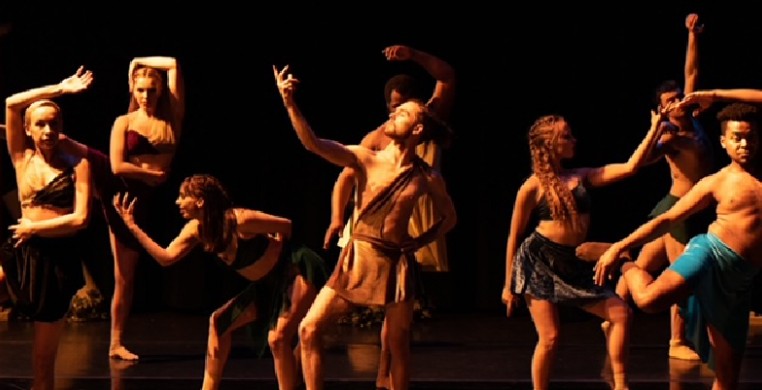In Plato’s “Republic,” the ancient Greek philosopher, Socrates, considered dance to be integral to the development of a virtuous man. “Rhythm and harmony," said Socrates, "permeate the innermost element of the soul, affect it more powerfully than anything else, and bring it grace…”
The writings of ancient Greece are still inspiring people to dance. “Pandora’s Box,” a new work by Ardent Dance Co. that ran from Nov. 18-20 at the Vittum Theater is choreographed by Artistic Director Justine Kelly and based on the story of Pandora, the first mortal woman of Greek mythology.
The work begins with the seventeen-member ensemble—men in tight-fitting, pastel-colored togas and briefs and women wearing decorated brassieres and thigh-high skirts—frozen in statuesque poses reminiscent of Hellenic sculpture, surrounded by short Doric-style columns draped in overgrown ivy. They come to life, the slow circle of arms overhead begins a ripple of rhythmic waves—this theme is repeated several times throughout the performance.
The pacing of each piece is to halt, move slowly, explode, halt, move slowly… When the timing of the rippled movements is clearly expressed, it produces wonderful visuals. There is a moment when the full company of dancers in a semi-straight, vertical line, unfurl their arms overhead and blossom like a slow-motion chrysanthemum, creating a dazzling kaleidoscopic effect of layers of color.
Jacqueline Tse deserves high praise for her portrayal of the titular character, Pandora. Tse’s solo performances are touching, the emotion in her eyes pouring through each beautiful and controlled extension of a leg. In a duet, Tse is cruelly flung around and dangerously pounced upon by her partner. She is an athlete of Olympic proportions. Despite being in nearly every other number in this long show, her energy only grows more intense.
Keenan Kangas is another workhorse. When solo, Kangas is an energetic spectacle, tracing a circle with energetic, twisting leaps. In a rotating love triangle of duets, he is delicate but strong, comfortable when launching one of them into the air and around his body, landing them delicately—Only to be launched himself and pulled violently back to the ground by his partner!
Next to Tse and Kangas, dancers Alexandra Green and Derrick Shenault are the most personable and give strong performances—especially Shenault, who lights up the stage with flashes from his sparkling, blue-shadowed eyes. A trio of women in the first act dancing to Klergys “World On Fire” stands out for the chemistry between the dancers and their capable execution of a push and pull, release and contract choreographic style, a refreshing departure from the otherwise congruous aesthetic of the rest of the show.
The work balks against the Western-Hellenic stereotype that all Greeks were blue-eyed, pale-skinned, and immaculately designed clones of actors Brad Pitt and Diane Kruger. The diverse cast includes a plethora of different bodies and succeeds where million-dollar movies fail, in that it resembles a closer relation to how ancient Greek people might have looked.
There are also a couple tender duets between two male dancers—Ben F. Locke, Wilson Hicken—that are powerful and accurate reflections of ancient Greek relationships—they didn’t have the sexual hang-ups that we’ve developed in the two-thousand years since.
The story is explained in a synopsis: Two brothers, the Titan gods Prometheus and Epimetheus, were charged with populating the Earth with animals and men. Epimetheus gave the animals all the good stuff—claws, sharp teeth, strength—so Prometheus stole fire from the gods to give to man so that they would have a fighting chance. In retaliation, Zeus creates Pandora, and sends her to the mortal realm armed with a jar (later mistranslated to “box”) containing all manner of misery and evil to be unleashed on mankind.
Vicious, fanged beasts! Mission Impossible-style pyro-thievery! The forces of good battling evil daimones!
None of these themes are clearly presented in “Pandora’s Box.” If the story is being told at all, it is in the abstract. The characters are not clearly represented by the dancers—the exception being Pandora, who for a short time carries around a box. There is no noticeable reference to the deliverance of fire to man by Prometheus other than a couple songs with the word “fire” in them.
Instead, we are presented with the story of a love triangle between three undefined characters, punctuated by random duets, solos and group numbers. Each number in the show clocks in around three or four minutes—At a two-hour run time, I estimate there to be a whopping thirty numbers!
The choreography of each work is so similar that they all bleed together. The music becomes amorphous, too, and the entire soundtrack lacks diversity, and sounds like one long end-credits theme following an action movie—wispy vocals, warlike drums, grandiose flourishes from horn and string instruments.
Tse is the glue that holds the show together. She is the only one who consistently matches movement to music in a cohesive way—the rest of the cast, eyes often focused on Tse’s feet, do their best to keep up, but are often half a second behind. The dancing appears unrehearsed despite the listing of three rehearsal directors in the program, two of whom commit some of the most egregious errors in the production.
Socrates made it clear in the “Republic” that “grace goes along with good rhythm, while bad rhythm goes along with the opposite sort, and the same goes for harmony and disharmony.” “Pandora’s Box” proves that quantity is not quality, and one imagines that if the performance were half as long it may have been twice as good.


